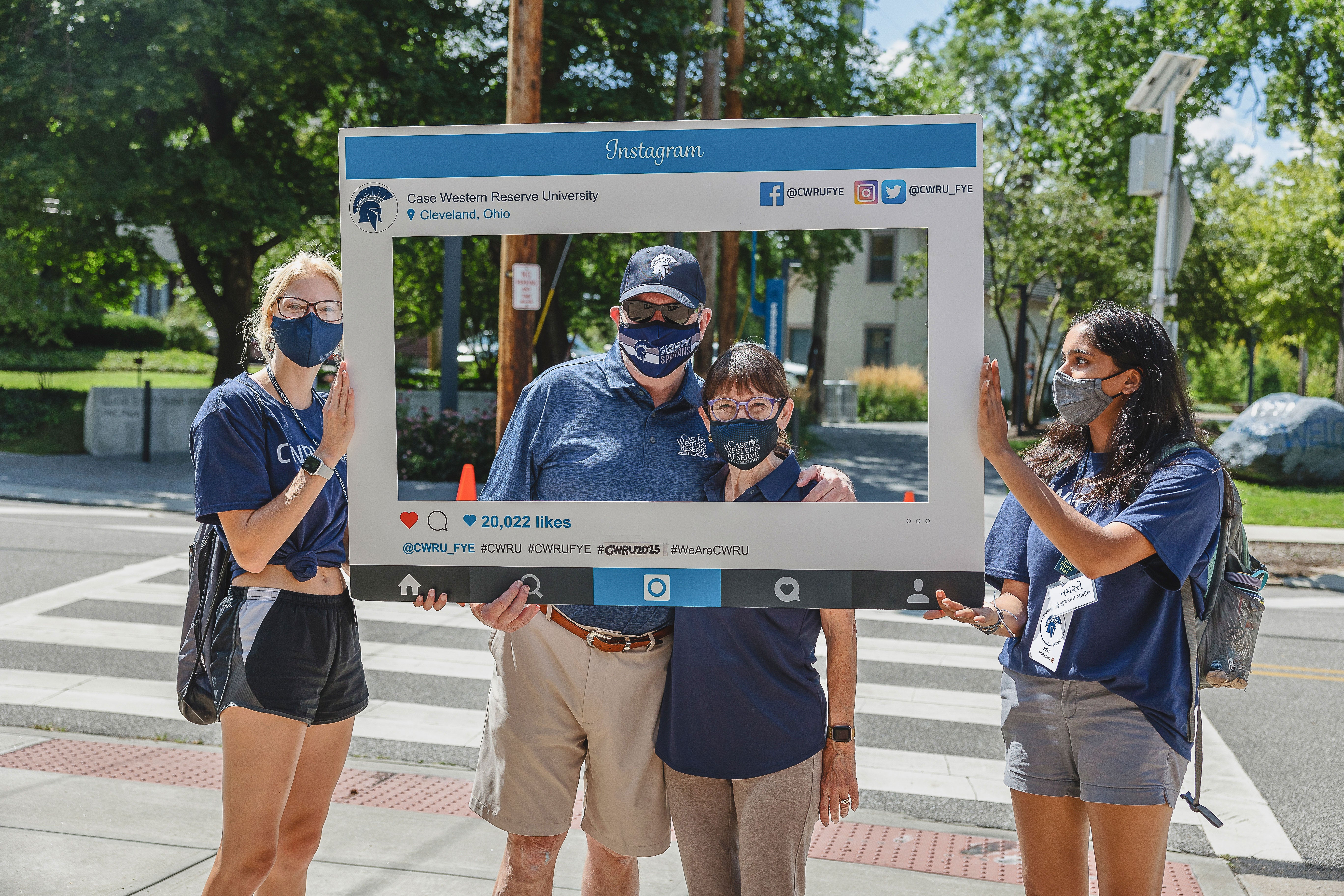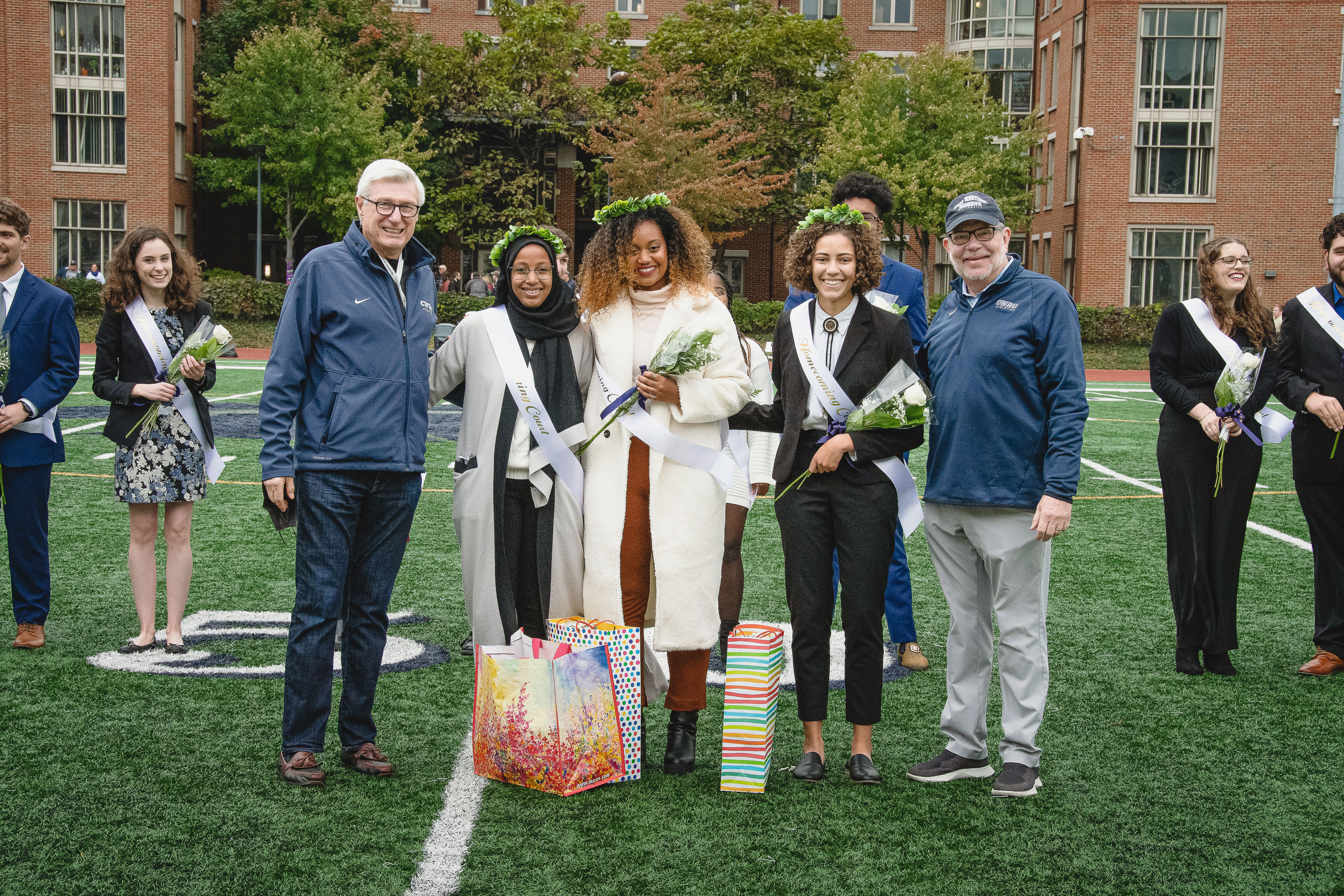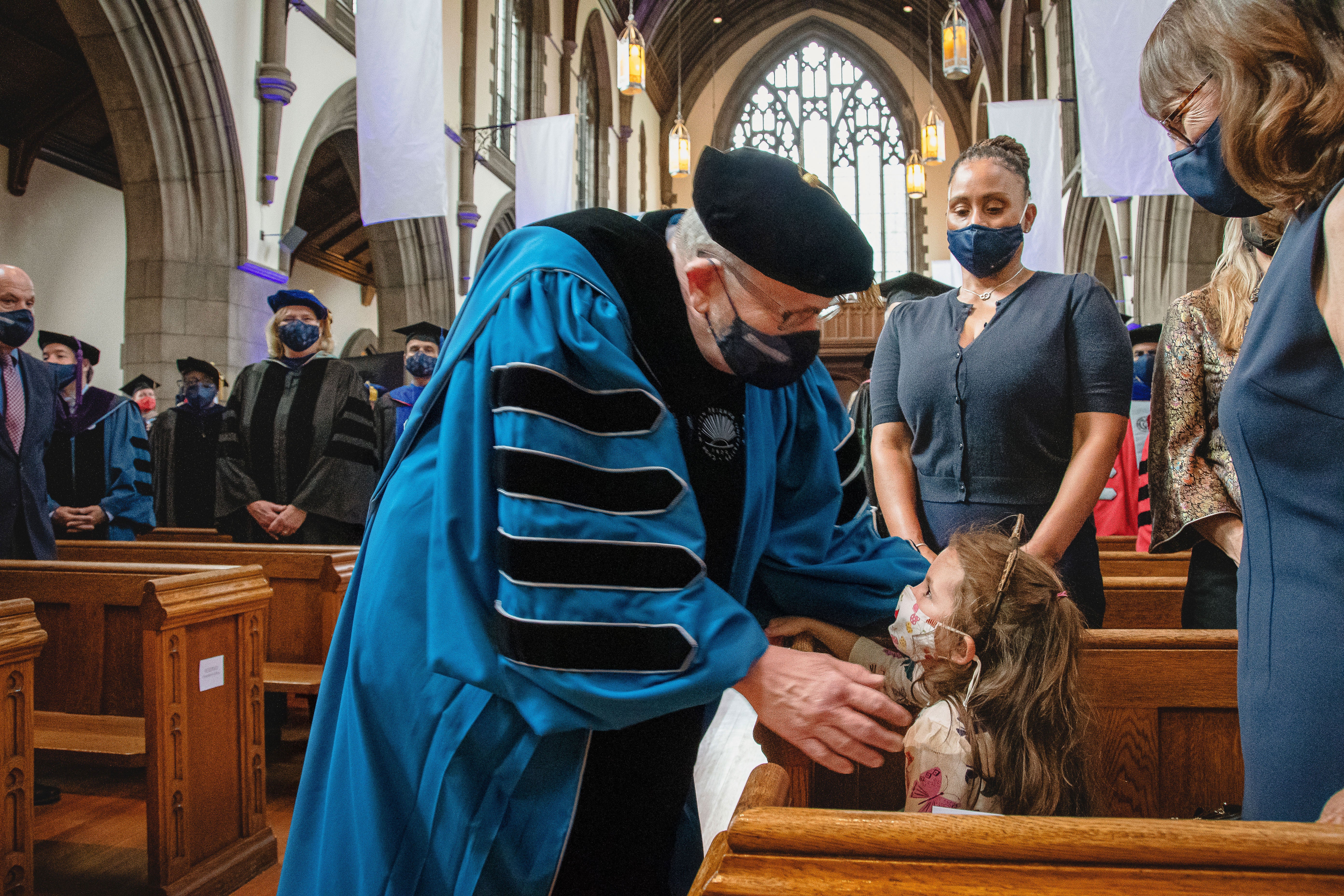features
Still Running
Eric Kaler continues the warp-speed pace that took him from first-generation college student to two-time university president
.jpg) PHOTO: Matt Shiffler
After the inauguration ceremony, President Eric Kaler and Board of Trustees Chair Fred DiSanto
(WRC ’85, MGT ’86) walk outside amid celebratory confetti.
PHOTO: Matt Shiffler
After the inauguration ceremony, President Eric Kaler and Board of Trustees Chair Fred DiSanto
(WRC ’85, MGT ’86) walk outside amid celebratory confetti.
Eric Kaler had just finished his first year of graduate school when he arrived in Knoxville, Tennessee, in the summer of 1979.
A first-generation college student from a small town in New Mexico, he had started at Caltech five years earlier only to find himself far less prepared than his peers.
Assigned to a lower-level physics course as a freshman, he was determined to advance—even if it meant enduring some teasing from the seniors he asked for help.
“Nothing was easy,” he recalled. “It took me two years to catch up.”
By the time Kaler was a senior, his college advisor was encouraging him to get a PhD—even offering to call colleagues at the University of Minnesota on his behalf. When he got to Minneapolis, he found the school’s highly competitive chemical engineering department had at least three dozen new graduate students, most from top schools across the country. This time, he welcomed the challenge.
“Let’s see if I can run with them,” he decided.
After his first year, Kaler had already shown some speed. With his advisor’s support, he had arranged summer access to a special X-ray scattering instrument he needed to use for his research. It was at the Oak Ridge National Research Laboratory, about a half-hour drive from the University of Tennessee (UT) residence halls where he’d put down a deposit.
But when he got to the UT front desk, the graduate student worker charged him the full rate—not the discounted one he had forgotten he had paid for. Something about this woman with the warm Southern accent blurred his memory.
When he saw her hours later, though, Karen Fults acknowledged the mistake and promised the university would soon send him a check. From then on, whenever Kaler saw Karen, he’d ask about the money—but in the nicest way he could muster.
Finally, he worked up the nerve to ask for what he really wanted: a date.
Six months later, the two married and the Nashville native moved to Minneapolis.
“You know how some people are laid back?” Karen said this summer. “Eric is more laid forward.”
 Photo: Matt Shiffler
Photo: Matt ShifflerPresident Eric Kaler and his wife, Karen, join students for move-in day festivities in August.
During nearly four decades in higher education, Eric W. Kaler, PhD, has always moved quickly. He earned his doctorate in four years, received a Presidential Young Investigator Award from the National Science Foundation two years later and, in 1987, five years after starting as an assistant professor at the University of Washington, won tenure.
But behind the rapid accumulation of accomplishments are actions less evident on a curriculum vitae. The decades of annual Thanksgiving dinners he and Karen hosted for graduate students who were away from family. His unwavering commitment to all of those students, even when they struggled mightily. And his willingness to pitch in wherever he might be needed—including washing sample containers for graduate students conducting experiments at the National Institutes of Standards and Technology in Gaithersburg, Maryland.
“The cleaning was laborious, tedious and necessary,” said Kaler’s 37th and final graduate student, Matthew Helgeson, PhD, now an associate professor of chemical engineering at the University of California at Santa Barbara. “Dr. Kaler would take it upon himself. ...That was something I really admired.”
Anthony Martino, PhD, now leading photovoltaics and materials technology at the prestigious Sandia National Laboratories, arrived in Seattle as a first-generation college graduate not entirely sure of what PhD projects required. Kaler suggested ideas, provided readings and tried multiple approaches to help him find a topic. Finally, he found an example that clicked for Martino.
Three decades later, “I’m proud of my career,” he said. “I’ve been at this fabulous research institute, one of the best in the world, and it would not have happened without him.”
With Hassan Madani, PhD, a graduate student from Iran, Kaler constantly emphasized the importance of good communication. Great discoveries counted little if their value could not be clearly conveyed. As hiring season neared, Kaler reviewed Madani’s application letters and coached him on presentations. When one interviewer mentioned trouble with particular proteins, Madani brought back a sample and Kaler gave permission to use his lab to work on the solution.
“I owe my entire career in biotechnology to him,” said Madani, now director for chemistry, manufacturing and controls at an international pharmaceutical company. “I look back, and everything he did was the right thing to help me in all aspects.”
By the early 1990s, Kaler was eager for a new challenge. He found it at the University of Delaware, which had a much larger and well-known chemical engineering department and greater opportunities for industry collaboration. Two years after his arrival, Kaler earned promotion to professor and, before long, was tapped as the department’s representative on a major building renovation project.
That role involved interactions with the president and provost, not to mention increased engagement with the faculty across his department. When the chair’s seat opened, colleagues urged him to take it—if not for himself, for them.
“He did it as a ‘good deed,’” Karen Kaler recalled. “He was not seeking to climb the leadership ladder.” As he dug into the day-to-day work of leading the department, Kaler began seeing things he didn’t like—first among them, a dearth of women and minority faculty members.
“Come on,” he recalled telling the faculty. “We’ve got to do better than this.”
One of those hired was Anne Skaja Robinson, PhD, now trustee professor and head of Carnegie Mellon University’s chemical engineering department. She had chosen Delaware over other offers because Kaler convinced her she could make a meaningful difference. Upon her arrival, she found herself admiring his decisive, data-driven approach.
But later, when she learned she was pregnant with her second child, she felt trepidation. Engineering was still overwhelmingly male at the time, and women who chose to have children often endured questions about their seriousness as scholars.
So it was with some hesitation that she emailed Kaler the news. Within 10 minutes, he called.
“Are you in your office?” he asked, then said he was on his way. What did that mean? she wondered.
When Kaler arrived, he had another question.
“‘Can I give you a hug?’” Robinson recalled him asking. “He was so happy for me. ... It was wonderful.”
A few years later, Kaler found himself being drafted for another leadership role. The university’s search for a new engineering dean had failed, and the provost was asking him to take the job. Kaler was reluctant; he still had an active research portfolio, and the chair’s job was demanding enough. Karen disagreed.
“If you say no and they get someone who isn’t good,” she told him, “you’ll have no one but yourself to blame.” He heeded her advice.
His commitment to diversity continued. As dean, when exhortations to look beyond the usual pool didn’t work, Kaler became more direct. He would not release funds for finalist visits to campus if the list did not include female and minority candidates. Each search committee could make the list larger to accommodate his mandate, and members could make the final choice. But they at least had to meet with a more diverse pool.
“A funny thing happened when they began interviewing women and minority candidates,” Kaler recalled. “They started recommending women and minority candidates.”
Within a few years, he began receiving inquiries about provost positions. Delaware’s president at the time, David Roselle, PhD, wasn’t surprised.
“He’s smart, really smart,” Roselle said recently of Kaler, who in 2010 won election to the National Academy of Engineering and, three years later, was named a Charter Fellow of the National Academy of Inventors. “He’s got a good sense of humor [and] he’s eager to help make the institution go faster and better.”
After three years as provost at Stony Brook University, Kaler learned that the president of University of Minnesota would be stepping down in 2011. As soon as he told Karen about the opening, she was certain they’d be moving back to Minneapolis. After reviewing nearly 150 candidates, the university’s regents proved her right.
During his eight years as president, the university made major gains across multiple metrics: Research spending grew by more than a third, while industry support for research jumped nearly 50%. The overall graduation rate climbed 17 points to 71%, and the gap between white and Black students’ graduation rates shrank by two-thirds. And he forged new agreements with the medical school’s hospital partner and physicians’ group in ways that strengthened bonds among all three. During that time, he was elected as a fellow of the American Academy of Arts and Sciences, one of the most significant and oldest learned societies in the United States.
In the summer of 2018, Kaler announced he would step down the following July, then spend a year fundraising for the university as its president emeritus. The $4 billion campaign he began in 2011 ultimately raised $4.4 billion, including $2 billion for research and faculty support.
As Kaler’s philanthropic efforts wound down, Case Western Reserve’s search for a new president was ramping up. When a consultant reached out regarding the opportunity, Kaler liked what he heard about the board’s strong interest in growing research and innovation, and continuing efforts around diversity and inclusion.
Forty years earlier as a graduate student, he had given his very first conference presentation in CWRU’s Strosacker Auditorium. There was something poetic about returning now—10 patents, nearly 240 journal articles and four administrative positions later.
“There is a tremendous fit,” he said after the trustees announced his appointment. “Once I looked, I got more excited ... [and thought] I’m really made for this job.”
Within two weeks of starting as CWRU’s president, Kaler announced the university would impose a COVID-19 vaccination mandate. The university had tried encouragement and incentives, but nearly a third of faculty, staff and students still had not verified their status. The new leader recognized the move would draw intense criticism from some, but he did not hesitate: While a university president has many responsibilities, none outweighs the safety of the campus community.
 Photo: Daniel Milner
Photo: Daniel MilnerStudent Affairs Vice President Lou Stark, far left, and President Kaler celebrate members of the Homecoming Court, including from left, Yageen (Queen) Hassan, Wintana Eyob and Camille Witt.
Two weeks after that announcement, the university announced a pilot program to give staff limited options for remote work. As the school year began, Kaler charged a task force to develop formal policies. A few weeks later, he appointed Stan Gerson, MD,—the medical school’s interim leader—as its permanent dean.
At nearly every campus appearance, Kaler emphasizes three primary themes: academic excellence, expansion of research and increased diversity and community engagement. In early November, he announced a national search for the university’s next research leader—the first in two decades to look for candidates for this job beyond the campus. During a jam-packed homecoming weekend schedule—including the Class of 2020’s pandemic-delayed in-person commencement—Kaler found time to appear at a morning memorial service for a beloved community activist, Mansfield Frazier, and to speak at the 10th anniversary celebration of the university’s Lesbian Gay Bisexual Transgender Center later that night.
“You are all welcome here,” he told the alumni gathered in the Thwing Center ballroom. “This campus community is your community.”
Those who work closely with Kaler know the one thing that consistently slows his usually rapid pace: family. His face alights whenever he sees his wife, Karen; he even sometimes looks a bit disappointed that he must move on to his next meeting. Fortunately, she frequently joins him at university events, and also hosts and co-hosts many of her own.
During his inauguration speech, Kaler called Karen “my best friend, my partner [and] my better two-thirds.”
That address also noted that his sons, Charlie and Sam, their wives, Lisa and Lizzy, and his “precious granddaughter, Ophelia” help inspire him every day.
Now nearly 5, Ophelia raced across the grass before the ceremony to join her parents as they processed toward Amasa Stone Chapel in full regalia. Once inside, she took the aisle seat in the row reserved for family.
 Photo: Daniel Milner
Photo: Daniel MilnerBefore reaching the inauguration stage, President Eric Kaler hugs his granddaughter, Ophelia. Watching them are Kaler’s wife, Karen, at right, and Associate Professor of Biology Yolanda Fortenberry in the row behind them.
As her grandfather approached, Ophelia reached out her hand. With hundreds watching in person and online, he immediately came to a full stop. With a smile that reached beyond his mask to his eyes, he took her hand in his. For a moment he looked ready to move forward, but instead leaned over to embrace her.
With a final glance at Karen, he stepped forward to be installed officially as Case Western Reserve University’s 11th president.





